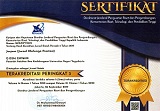MENGENDALIKAN KADAR KOLESTEROL PADA HIPERKOLESTEROLEMIA
DOI:
https://doi.org/10.21831/jorpres.v11i2.5749Abstract
Hiperkolesterol ialah keadaan dimana kadar kolesterol dalam tubuh melebihikeadaan normal Hiperkolesterol dapat meningkatkan risiko terkena aterosklerosis, penyakitjantung koroner, pankreatitis (peradangan pada organ pankreas), diabetes melitus,gangguan tiroid, penyakit hepar & penyakit ginjal (Indratni, 2009). Faktor penyebabhiperkolesterol diantaranya, faktor keturunan, konsumsi makanan tinggi lemak, kurangolahraga dan kebiasaan merokok.Penanganan diperlukan untuk mengendalikan kadar kolesterol darah sebagai upayamencegah terjadinya dampak lebih lanjut dari hiperkolesterol. Therapeutic Lifestyle Changes(TLC) mencakup penurunan asupan lemak jenuh dan kolesterol, pemilihan bahan makananyang dapat menurunkan kadar LDL, penurunan berat badan, dan peningkatan aktivitas fisikyang teratur. Perubahan gaya hidup sangat dipengaruhi oleh motivasi diri dan lingkunganyang memerlukan konseling gizi yang baik dan berkelanjutan.Terapi bekam menurunkan kadar kolesterol pada pasien hiperkolesterol umur 45tahun ke atas dan Pemberian jus buah naga merah pada kelompok perlakuan dengan dosis2,86gr/kgBB setiap hari selama 21 hari berpengaruh secara bermakna terhadap penurunankadar kolesterol total pria hiperkolesterolemia.Kata Kunci: kadar kolesterol dan hiperkolesterolemia
Downloads
How to Cite
Yani, M. (2015). MENGENDALIKAN KADAR KOLESTEROL PADA HIPERKOLESTEROLEMIA. Jorpres (Jurnal Olahraga Prestasi), 11(2). https://doi.org/10.21831/jorpres.v11i2.5749
Issue
Section
Articles
License
Authors who publish with this journal agree to the following terms:
- Authors retain copyright and grant the journal right of first publication with the work simultaneously licensed under a Creative Commons Attribution License that allows others to share the work with an acknowledgement of the work's authorship and initial publication in this journal.
- Authors are able to enter into separate, additional contractual arrangements for the non-exclusive distribution of the journal's published version of the work (e.g., post it to an institutional repository or publish it in a book), with an acknowledgement of its initial publication in this journal.
- Authors are permitted and encouraged to post their work online (e.g., in institutional repositories or on their website) prior to and during the submission process, as it can lead to productive exchanges, as well as earlier and greater citation of published work (See The Effect of Open Access).




